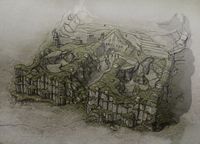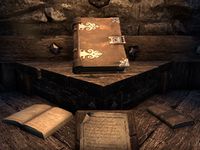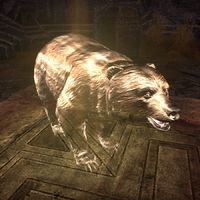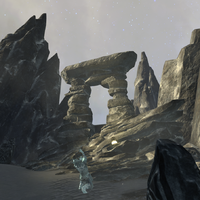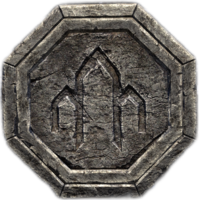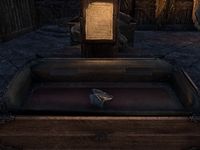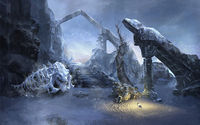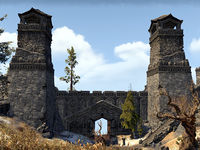Lore:Torug gro-Igron
| King Torug gro-Igron | |||
|---|---|---|---|
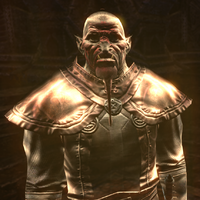 King Torug gro-Igron as a shade
King Torug gro-Igron as a shade |
|||
| Race | Orc | Gender | Male |
| Died | First Era Sorrow |
||
| Resided in | Orsinium | ||
| Next Ruler | Golkarr | ||
| Appears in | ESO | ||
King Torug gro-Igron was an Orcish chieftain who founded the first Orsinium in the Wrothgarian Mountains of High Rock. It grew from an armed camp into a kingdom under his rule in the early First Era, though objective details on that kingdom are not known.[1] Chronicles of the time paint Orsinium a fortress ruled by savage law, leading raids on its neighbors along the Bjoulsae River. Orc historians call it a utopia, a peaceable land of agriculture and commerce. The truth is likely somewhere in between, but all written and archeological evidence was destroyed in the thirty-year Siege of Orsinium.[2] Torug had died long before the time the siege began in 1E 950,[3] as Orsinium was then ruled by King Golkarr.[4] The exact date of Orsinium's founding is unknown, but it is known to have grown powerful as early as the ninth century of the First Era.[5][6] Though some sources place the founding of Torug's Orsinium in the tenth century.[2]
Contents
History[edit]
Founding Orsinium[edit]
During the First Era, after hundreds of orcs, ogres, goblins, gremlins and other beastfolk were set free by the Altmer during the Camoran Dynasty, they chose to settle in an uninhabited mountain region close to Old Hroldan in High Rock, as their people were dependent on a rare, shaggy, giant centipede herd-beast that can only survive at high altitudes, here is where the first Orsinium would be founded.[7]
Almost nothing is known about Torug gro-Igron prior to the establishment of Orsinium. The earliest accounts mention Torug gathered his people together high in the Wrothgarian Mountains. It was here four Orcish clans, including Torug's own, worked together and built what started out as a modest settlement.[3] According to "Thugbo's Map of Clans", thirteen clans had established strongholds in Wrothgar, but its unknown why only four partook in building Orsinium.[8][9]
Torug possessed a powerful relic known as the Armlet of Torug, and according to legend the magical bracelet was able to tame the savage wilderness of Wrothgar and allow him to establish Orsinium.[10] Tumnosh Clan , the great builders, carved and shaped Orsinium from the very mountains. Morkul Clan's master craftsmen provided arms and armor, giving Orsinium its second pillar of strength. The peerless hunters of Shatul Clan, provided the others with sustenance while Torug's clan served as rulers with Torug himself as chieftain.[11] Numerous accounts describe an iron bell Torug erected in the settlement, which he rang to gather the clans for fellowship, and later to gather the clans for war.[3] Far from their enemies, the armed camp grew into a village, and the village expanded into a town. In just a few short years more permanent structures were built and Orsinium became a sprawling, indefensible mass of people and buildings that were ripe for attack. Forge-wife Mortuga, the first and greatest of King Torug's many wives, sought out a master stonemason to build a wall around the city and define its borders. Kuthbarg the Steady was chosen, and he successfully raised strong walls around Orsinium that endured for centuries.[1] Word spread to the far-flung Orcs of Tamriel that there was an Orcish homeland that would welcome them and give them refuge. According to the "Myth of Mauloch", the Orcs had been pariahs of the land for the last two hundred years or longer.[2] Among those other orcs that would join them are those who were fleeing Hammerfell due to the Ra Gada invasion.[7] Warlord Thulgeg led a group of Orcs and Goblins from Hammerfell on an exodus to High Rock in 1E 874 after being driven out of the province by the Redguards, eventually leading them northeast through the Dragontail Mountains before they finally reached Orsinium.[6][12] According to Kraltha the Rememberer he contributed to the founding of the city.[13]
Torug wanted Orsinium to be more than just another Orc settlement. He envisioned a grand city of prosperity and civilization, but he wanted it to be a reflection and advancement of Orc culture. To this end, he created a set of rights and privileges that defined the organization of the settlement and preserved what Torug thought was most important about Orc life - a document now known as the First Charter.[14]
Coldwind[edit]
King Torug allied with the mightiest snow bear of Wrothgar after earning her trust. According to legend, Torug spilled his own blood to draw out her, brought echatere meat and clean water to feed her and brought fire to warm her. Coldwind accepted King Torug's offerings, for Torug had treated her as an equal, and not as a master.[15]
The beast earned the name "Coldwind" by being fast and icily brave while serving as the king's mount in hundreds of battles, and also led to King Torug founding Orsinium's Bear-Rider cavalry. By taming Coldwind, Torug supposedly bent all the bears of the land to his will.[16] After many years of service, Coldwind grew weary so Torug found her a den in the far north so the bear could retire and pass on her bloodline to many powerful cubs. When Coldwind eventually died, King Torugg was said to have grieved fivefold for the death of his beloved bear mount. He decreed that his faithful friend should have a tomb worthy of his deeds, and so he turned part of the den into a tomb and implored Malacath to send Daedra to protect it.[17][18]
Death[edit]
Prior to his passing, King Torug began preparing his tomb atop the deadly cold mountain known as Sorrow. According to legend, Torug sacrificed seven clans to build his tomb, but was unhappy they built his shrine below the summit. According to tradition, the ancient Orcs built memorials to their champions on Sorrow's slopes. The higher the location of the tomb, the greater the sacrifice and prestige, and King Torug wanted to rest at the top.[19]
Torug inscribed various monuments on the path leading to his tomb with three-stanza epitaphs declaring he would not allow looters to find his remains, allow lesser Orcs to be buried above him, and be buried with his enchanted armlet, waiting for a worthy Orc to claim his most cherished possession.[20] When the time of his death neared, Torug climbed the mountain with his armlet but decided to abandoned his own tomb. Instead he climbed higher towards the peak of the mountain to die, and it was here where he would meet his end.[19]
Armlet of Torug[edit]
In 2E 582, the House of Orsimer Glories in the newly rebuit Orsinium hired the famed treasure hunter Lady Laurent and her faithful manservant, along with an Orcish scholar who specialized in King Torug's history, to climb Sorrow and recover the Armlet of Torug for the museum. With the aid of the Vestige, the group climbed up the mountainside, braving beasts and avalanches to recover the armlet.
The fate of the armlet was disputed among the expedition team. Some argued the armlet could become a symbol to bind the Orcs together and a tribute to our past glories. It should remain on the mountain so that future Orcs would be required to climb Sorrow to see it, and understand what Torug and their ancestors were capable of achieving. Others argued that such an important relic belonged in the museum, where every Orc could gaze upon it in comfort. Ultimately, the fate of the armlet remains unknown.[21]
Legacy[edit]
King Torug is honored and revered among many Orcs centuries after his death. Many Orcish arms and armor bear his visage, supposedly to strike fear into the heart of any who dared oppose the wearer, including sword hilts, maces, quivers and breastplates.[22] When Gortwog gro-Nagorm built Nova Orsinium in 3E 399, the city was graced by iron statues of Orc heroes including Torug.[2] Various legends surrounding Torug are recorded in the "Torug Edda".[18]
Gallery[edit]
See Also[edit]
Books[edit]
- Torug at the Summit, Complete Translation — A translated text surrounding the death and resting place of Orsinium's founder
Notes[edit]
- Torug gro-Igron supposedly loved bows and became proficient while hunting game, although most of the time he's depicted wielding dual axes.[23]
- During the mid-Second Era, an old iron mine in Bangkorai was named "Torog's Spite".
References[edit]
- ^ a b Hammer of Glass
- ^ a b c d Pocket Guide to the Empire, 3rd Edition: Orsinium — Imperial Geographical Society, 3E 432
- ^ a b c Orsinium Cracked Iron Bell antiquities codex in ESO
- ^ The Great Siege of Orsinium
- ^ Wayrest, Jewel of the Bay — Sathyr Longleat
- ^ a b Bangkorai, Shield of High Rock — King Eamond
- ^ a b Pocket Guide to the Empire, 1st Edition: The Wild Regions — Imperial Geographical Society, 2E 864
- ^ Map of Clans
- ^ Antique Map of Wrothgar antiquities codex in ESO
- ^ Armlet of Torug
- ^ Flames of Forge and Fallen quest in ESO: Orsinium
- ^ Scholar Cogline's dialogue in ESO
- ^ Thulgeg's March — Kraltha the Rememberer
- ^ The First Charter
- ^ A Cold Wind From the Mountain quest in ESO: Orsinium
- ^ Curator Umutha's dialogue in ESO: Orsinium
- ^ Coldwind's Skull
- ^ a b Coldwind's Den loading screen in ESO
- ^ a b Kharsthun's dialogue in ESO: Orsinium
- ^ Torug at the Summit, Complete Translation
- ^ Sorrow's Kiss quest in ESO
- ^ Crafting Motif 88: Ancestral Orc Style — Armelle Menant, Historian of Glenumbra
- ^ Ancestral Orc: Bows antiquities codex in ESO
